CAA News Today
New CAA Member Benefit: Humanities E-Book
posted by Nia Page — December 04, 2009
 Humanities E-Book, a project of the American Council of Learned Societies (ACLS), offers unlimited access to its collection of nearly three thousand cross-searchable, full-text titles across the humanities and related social sciences. Titles, which include fifty-six CAA Monographs on the Fine Arts, have been selected and peer reviewed by ACLS constituent learned societies for their continued importance and value in teaching and researching. The collection, which grows by about five hundred books a year, includes both in- and out-of-print titles published from the 1880s to the present. Humanities E-Book titles also link to publishers’ websites and to online reviews in JSTOR, Project MUSE, and other sites.
Humanities E-Book, a project of the American Council of Learned Societies (ACLS), offers unlimited access to its collection of nearly three thousand cross-searchable, full-text titles across the humanities and related social sciences. Titles, which include fifty-six CAA Monographs on the Fine Arts, have been selected and peer reviewed by ACLS constituent learned societies for their continued importance and value in teaching and researching. The collection, which grows by about five hundred books a year, includes both in- and out-of-print titles published from the 1880s to the present. Humanities E-Book titles also link to publishers’ websites and to online reviews in JSTOR, Project MUSE, and other sites.
Individual Subscriptions
As a special benefit of CAA membership, individual members can acquire a twelve-month, renewable subscription to Humanities E-Book for $35, which helps sustain the resource for the entire scholarly community.
Individual subscriptions are an attractive option for those whose institutions do not already subscribe to Humanities E-Book, or for CAA members who might not be affiliated with a subscribing institution. Please check this list to see if your institution subscribes.
When completing the Humanities E-Book’s online purchase module, choose the College Art Association from the Society Affiliation pull-down menu and enter your CAA member number. Be sure to review the terms of service before subscribing. For inquiries, please write to subscriptions@hebook.org or call 212-697-1505.
Institutional Subscriptions
Humanities E-Book offers a special 10 percent discount on subscriptions to institutional CAA members. Subscriptions range from $450 to $3,125, depending on the size of your institution.
Institutional subscription information, including pricing, is available on the Humanities E-Book website. For a free trial, a subscription for your school, museum, or organization, or further information, please write to info@hebook.org and mention that you are an institutional CAA member.
Google Books Settlement
posted by Christopher Howard — November 09, 2009
Today is the deadline for a revised settlement agreement to be filed in response to a lawsuit by the Authors Guild and the Association of American Publishers, who are protesting the unauthorized copying of in-copyright books by Google.
CAA has prepared a summary article on the Google Library Book Project to better inform you about the issues at stake; included are a brief description of aspects of the settlement and links to articles and editorials from authors and reporters supporting or criticizing the settlement.
CAA’s constituency includes both creators and users of books. The Committee on Intellectual Property has taken up the matter for consideration and is currently considering what position, if any, to recommend.
New Report Compares Virtual-Gallery Software
posted by Christopher Howard — October 20, 2009
 Technology in the Arts has published a free report, entitled Virtual Gallery Software Review, that reviews and compares three software applications—Virtual Galleries, Image Armada, and SceneCaster/3D Scenes—designed to help artists, curators, and art organizations create three-dimensional virtual exhibitions. This type of technology can provide not only a useful alternative experience for audiences that cannot physically attend a live exhibition, but it can also potentially help students and professionals learn about exhibition planning and installation.
Technology in the Arts has published a free report, entitled Virtual Gallery Software Review, that reviews and compares three software applications—Virtual Galleries, Image Armada, and SceneCaster/3D Scenes—designed to help artists, curators, and art organizations create three-dimensional virtual exhibitions. This type of technology can provide not only a useful alternative experience for audiences that cannot physically attend a live exhibition, but it can also potentially help students and professionals learn about exhibition planning and installation.
The task of building virtual galleries or exhibitions can often be daunting and costly. Despite software that facilitates the development of virtual environments for conferences, commercial expos, and education, solutions for creating virtual art exhibitions have been scarce. For these reasons, two important criteria for the study were ease of use and user-friendly design. The primacy of these criteria also prompted the researchers to exclude Second Life because of its steep learning curve for environment creation.
Researchers looked for five features desirable in an application used by artists and arts professionals: ease of creating an exhibition; quality of images; flexibility of creating an exhibition; ease of navigation in the three-dimensional space; and ease of publishing or distributing the gallery. The report contains individual descriptions of the three applications, as well as comparisons of their features, such as Mac and PC compatibility, hardware requirements, internet-based viewing, and image and lighting manipulation.
Technology in the Arts, an organization that explores the intersection of arts management and technology, offers services such as consulting, professional-development training, webinars, an online resource directory, monthly podcasts, and a discussion-based blog. It is part of the Center for Arts Management and Technology, an applied research center at Carnegie Mellon University exploring ways in which arts managers can employ online technologies to meet their organizational goals and engage audiences more effectively.
Free Public Program in New York on Orphan Works
posted by Christopher Howard — October 14, 2009
CAA invites members in the tristate area of New York, Connecticut, and New Jersey to attend an upcoming panel on orphan works, entitled “Lost and Found: A Practical Look at Orphan Works.” The program is free and open to the public, but registration is required.
Lost and Found: A Practical Look at Orphan Works
Tuesday, October 20, 2009
Meeting Hall, New York City Bar Association, 42 West 44th Street, New York
How should the law treat “orphan works”? Please join us as we discuss proposals that would enable copyrighted works to be used when their owners cannot be located to obtain necessary permissions. What should be the obligations of potential users with respect to searching for copyright owners? How should infringement claims be handled if a copyright owner emerges? Do different types of copyrighted works present unique issues? What roles might registries and recognition and detection technologies play? Our speakers will address these and related questions, focusing on orphan images.
June M. Besek, executive director of the Kernochan Center for Law, Media, and the Arts, is the panel moderator. Speakers are:
- Brendan M. Connell, Jr., Director and Counsel for Administration, Solomon R. Guggenheim Foundation
- Frederic Haber, Vice President and General Counsel, Copyright Clearance Center
- Eugene H. Mopsik, Executive Director, American Society of Media Photographers
- Maria Pallante, Associate Register for Policy and International Affairs, US Copyright Office
- Charles Wright, Vice President and Associate General Counsel, Legal and Business Affairs, A&E Television Networks
“Lost and Found” is sponsored by the Art Law Committee (chaired by Virginia Rutledge) and the Copyright and Literary Property Committee (chaired by Joel L. Hecker) of the New York City Bar Association, in conjunction with Columbia Law School’s Kernochan Center for Law, Media, and the Arts.
Should Libraries Toss Their Old Print Journals? A New Report on Digitizing Library Collections
posted by Christopher Howard — October 06, 2009
Many journals are sufficiently preserved digitally and housed in print repositories so that some libraries can responsibly withdraw their own print holdings, according to a new report published by Ithaka S+R. Written by Roger Schonfeld and Ross Housewright, “What to Withdraw: Print Collections Management in the Wake of Digitization” takes a system-wide approach to the needs of libraries and their users collectively, rather than focusing on regions, systems, or consortia.
“Libraries are right to push aggressively into the digital future but should do so with an awareness about risk and tradeoffs,” said Housewright, an analyst at Ithaka S+R, the strategy and research arm of the nonprofit organization ITHAKA, which is also the parent company of JSTOR and Portico.
Looking at reasons for retaining and preserving physical copies of scholarly journals, “What to Withdraw” proposes minimum time periods that require libraries to give access to both print and digital versions. It then offers a minimum number of required print copies to retain. Based on this analysis, the report concludes that certain print journal backfile sets are well enough digitized and contain few enough images that it is unlikely there will be future demand for them by users.
Some print materials, the authors warn, may not yet be ready for broad withdrawal without risk. For these materials, several strategies are recommended to give libraries more flexibility. First, organizations responsible for digitization programs should provide more transparency on the quality of their digitization work and participate in ongoing efforts to upgrade the quality of their scans. In addition, libraries should form deeper partnerships with publishers and other digitizers.
“There is an opportunity before us to make a system-wide impact on print collection management,” said Housewright, “but in order to do so libraries and digitizers need to commit to collaboration at a level unseen today.”
Resources for Catalogues Raisonnés and for Art Law and Cultural Property
posted by Christopher Howard — September 24, 2009
The International Foundation for Art Research (IFAR), a nonprofit educational and research organization dedicated to integrity in the visual arts, has launched two important resources for the art community on its recently expanded and redesigned website: the Catalogue Raisonné Database and Art Law and Cultural Property.
The Catalogue Raisonné Database comprises two integrated electronic databases—one for published catalogues raisonnés, the other for catalogues in preparation—that can be searched individually or in unison. IFAR asks anyone who is aware of a published or in-preparation catalogue raisonné not included in our database (currently at more than two thousand entries) to contact the organization by clicking on the link “Tell Us about Catalogues Raisonnés” and completing the electronic form.
Art Law and Cultural Property helps users to navigate the mushrooming and complex body of legislation and case law relating to the acquisition, ownership, and authenticity of art objects. The website has two principal components: International Cultural Property Ownership and Export Legislation, with texts in original language and English translation from, currently, more than eighty countries; and Case Law and Statutes, with summaries of legal cases in eight subject areas relating to IFAR’s fields of interest. A section on professional guidelines, a glossary, and images are also included.
These two double the offerings from IFAR’s current online educational resources, which also include Provenance Guide and Collectors’ Corner. CAA maintains its own website resource, Intellectual Property and the Arts.
Witt and Conway Libraries at the Courtauld to Remain Open
posted by Christopher Howard — August 27, 2009
 Rumors have been circulating this summer about a possible closure of the Witt Library and the Conway Library at the Courtauld Institute of Art in England, a situation reported on last month by Martin Bailey in the Art Newspaper. The good news is that the two libraries will remain open for scholars and the public—but only after a two-month temporary shuttering beginning early next month. Yesterday CAA received the following missive from the venerable London-based art institution:
Rumors have been circulating this summer about a possible closure of the Witt Library and the Conway Library at the Courtauld Institute of Art in England, a situation reported on last month by Martin Bailey in the Art Newspaper. The good news is that the two libraries will remain open for scholars and the public—but only after a two-month temporary shuttering beginning early next month. Yesterday CAA received the following missive from the venerable London-based art institution:
The Courtauld Institute of Art is pleased to confirm that the Witt and Conway Libraries will remain open to the public five days a week and [that] the Photographic Survey collections will continue to be accessible by appointment, contrary to concerns recently expressed by some members of the art community.
Like other higher education institutions worldwide, The Courtauld has had to review all its operational activities and services in the light of the current economic climate. This review has led to a decision to restructure the management of our image libraries in order to minimise their net cost to the Institute. To allow time to implement the agreed changes, these libraries will be temporarily closed from 7 September 2009 and will reopen on 2 November 2009. They will then be open to the public from Monday to Friday between the hours of 11am and 4pm (subject to usual Bank Holidays etc).
Requests for photographs, rights and reproduction rights from the Witt and Conway Libraries should continue to be addressed to Courtauld Images: +44 (0)20 7848 2879, images@courtauld.ac.uk or via www.courtauldimages.com.
The Witt Library houses a collection of about 2 million reproductions of Western paintings, drawings, and prints from 1200 AD to the present. The Conway Library has more than 1 million images, including photographs and cuttings of architecture, architectural drawings and publications, sculpture, ivories, seals, metalwork, manuscript illumination, stained glass, wall paintings, panel paintings, and textiles.
Louvre Launches English-Language Version of Its Online Collection Database
posted by Christopher Howard — July 30, 2009
 Today the Musée du Louvre in Paris has launched an English-language version of its online collection database, Atlas. This interactive research tool will allow visitors to access information on 22,000 artworks from the Louvre, view high-resolution images of masterpieces, and locate exhibited works and galleries throughout the museum. Previously available only in French, Atlas is accessible free-of-charge.
Today the Musée du Louvre in Paris has launched an English-language version of its online collection database, Atlas. This interactive research tool will allow visitors to access information on 22,000 artworks from the Louvre, view high-resolution images of masterpieces, and locate exhibited works and galleries throughout the museum. Previously available only in French, Atlas is accessible free-of-charge.
Users can enter via the main Louvre website, choose English at upper right, and then go to Collections –> Databases and select Atlas.
The launch of the English version of Atlas was initiated by and funded with a €300,000 ($380,000) grant in 2004 from the American Friends of the Louvre, which was founded in 2002 to strengthen ties between the museum and its American public. The new version of the site will provide in-depth information on the Louvre’s extensive collection to the museum’s two million English-speaking visitors as well as to educators, students, researchers, and scholars.
Launched in 2003, Atlas provides quick and easy access to an exceptionally rich database of 26,000 of the 35,000 works on permanent display at the Louvre. Currently, 5,500 artists in a variety of media are represented on the site. In addition to gallery views, Atlas also provides online visitors with a virtual “Album” through which they can gather a selection of artworks and create and navigate their own personalized tour of the Louvre.
The English-language version of Atlas will include entries on 22,000 works of art, or approximately 80 percent of the original Atlas database, showcasing works most representative of the depth and scope of the Louvre’s collection.
Roundup of Legal Issues in Art and Academia
posted by Christopher Howard — July 22, 2009
CAA rounds up several legal issues related to the art and academic worlds.
US Ban on Muslim Scholar
Last week the US Court of Appeals for the Second Circuit reversed a lower court’s decision regarding Tariq Ramadan, a Swiss Muslim professor who was not allowed into the country to teach at the University of Notre Dame. The State Department revoked Ramadan’s visa in 2004 via the USA Patriot Act and then denied another one two years later because he contributed to a charity that was allegedly supporting Hamas, a Palestinian group that is a terrorist group in the eyes of the American government. Ramadan may now be able to dispute this claim, which could reinstate his visa status.
Three groups—the American Academy of Religion, the American Association of University Professors, and PEN American Center—worked with the American Civil Liberties Union on the case. The New York Times has the story on the recent ruling.
Shepard Fairey’s Obama Poster
The photographer whose image was used in Shepard Fairey’s iconic poster of Barack Obama argues that the Associated Press, who is suing Fairey for copyright infringement, does not actually possess the photograph’s copyright. Erik Larsen at Bloomberg has more details.
National Gallery and Digital Images
The National Portrait Gallery in London is threatening a lawsuit against Derrick Coetzee, a Seattle man who downloaded thousands of high-resolution images from the museum’s website and posted many on Wikipedia. In the US, photographs of two-dimensional works of art are not protected by copyright because the photographs lack originality (per Bridgeman Art Library v. Corel Corp from 1999). In the UK, however, there is not a similar legal precedent. The Independent and the Guardian have reported on the developing story.
Avery Index to Architectural Periodicals Returns to Columbia University
posted by Christopher Howard — July 10, 2009
 The J. Paul Getty Trust in Los Angeles has returned full ownership of the Avery Index to Architectural Periodicals to Columbia University in New York. Produced since 1934 at Columbia’s Avery Architectural and Fine Arts Library, the internet-based index has been operated by both institutions for twenty-six years, with the Getty providing funding and technical and administrative support while Columbia managed its production.
The J. Paul Getty Trust in Los Angeles has returned full ownership of the Avery Index to Architectural Periodicals to Columbia University in New York. Produced since 1934 at Columbia’s Avery Architectural and Fine Arts Library, the internet-based index has been operated by both institutions for twenty-six years, with the Getty providing funding and technical and administrative support while Columbia managed its production.
An essential research tool, the Avery Index provides a comprehensive listing of journal articles published worldwide on architecture and design, city planning, interior design, landscape architecture, and historic preservation. At present, about 225 institutions are subscribers, which comprise nearly all major academic institutions internationally who support research in architecture.
Last spring, in connection with Getty-wide budget reductions, the Getty Research Institute (GRI) announced its intention to transfer the index back to Columbia. Moreover, says GRI director Thomas Gaehtgens, the index has become increasingly self-supporting.
Columbia and the Getty will ensure a seamless transition for users of the index, coordinating continuing distribution agreements as they have in the past. The Getty will continue providing administrative and technical support during the transition period from July 1, 2009 until December 31, 2009.


